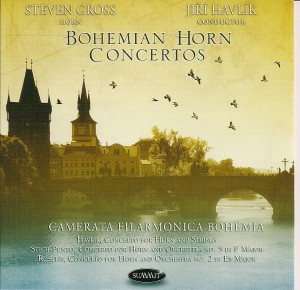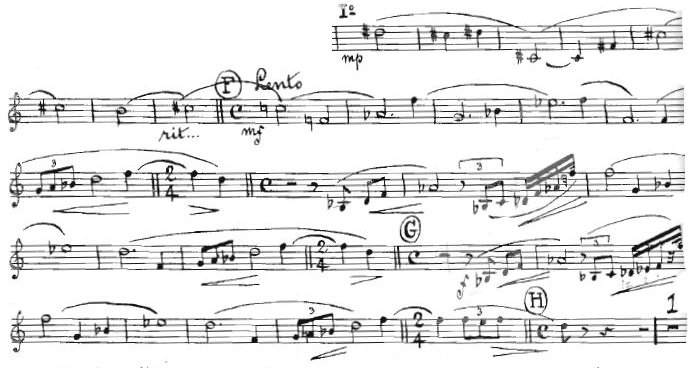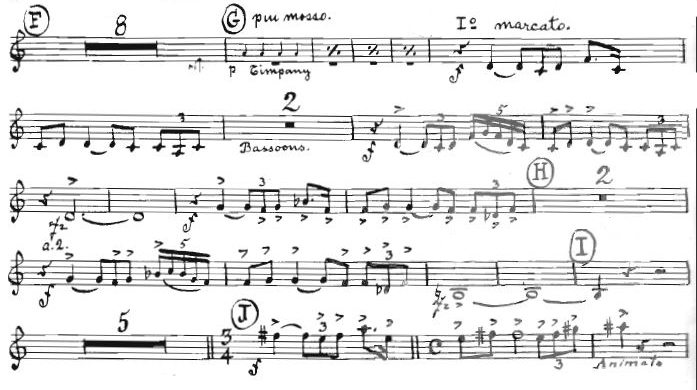![]()
![]()
To continue this series we today have what is likely to be one of the longer articles posted, as it is on a topic where the conventional wisdom needs reexamined. It will conclude as well with a look at an exciting new model of early Classical natural horn that is now available for purchase and use today.
Dresden hornist Anton Joseph Hampel (1710-1771) is frequently credited with either inventing or codifying hand horn technique sometime after 1750. The primary source behind this is the Méthode de Premier et de Second Cor (1808) of Heinrich Domnich (1767-1844). Domnich was a student of the great horn virtuoso Johann Stich (1746-1803), who was better known under the Italianized name of Giovanni Punto, and it is thought that Domnich had obtained his information from Punto. Punto had been a pupil of Hampel and later also published an edition of a horn method by Hampel.
To briefly summarize the account presented by Domnich, Hampel was experimenting with mutes of wood when he was struck by the idea of inserting a pad of cotton into the bell of the horn, inspired by contemporary oboe players who inserted cotton into the bell of the oboe to soften the tone of the instrument. In the words of Domnich,
It was a ray of light to him … he saw the means, by introducing and pulling out the stopper alternately, of running through the diatonic and chromatic scale of all keys without interruption. Then he composed for the horn new music where he introduced some notes which until now were strange to him. Some time after, having noticed that the stopper could be replaced advantageously by the hand, he ceased to use it.
Before this revolution, fortunate as it was brilliant, the manner of holding the horn was the same as that used today (1808) for the tromp de chasse [hunting horn]. But as the arm on which it was supported was required for the execution of the stopped notes, the holding of the instrument was changed….
Creator, in a sense, of a new instrument, Hampel, who was not experienced in his youth in the practice of stopped notes, restricted the usage to slow pieces. It was reserved for one of his disciples to give to this discovery all the extension and brilliance of which it was capable.
[Heinrich Domnich, Méthode de Premier et de Second Cor (Paris: Le Roy, 1808), III-V, trans. in Birchard Coar, A Critical Study of the Nineteenth Century Horn Virtuosi in France (DeKalb, IL: Birchard Coar, 1952), 6-8.]
Domnich was the first to answer the question of who invented hand horn technique and virtually every account since that date has in one way or another simply repeated his account. It is worth noting that the account of Domnich was published after the death of Punto, the supposed source of this information on events which had occurred over 50 years previously. The story Domnich presented is certainly very believable, but, on the other hand, believability is certainly not a standard by which one can prove anything to be a factual, accurate assessment of history. In fact, a skeptic could even begin to question the motives of Domnich, Punto, or both for presenting this story. Without question there is a certain note of status and authority a musician obtains by having received information passed on to them directly from a famous expert–and Hampel we are told invented hand horn technique, making him the final expert on this important topic. Did Domnich present facts in his story, or did he or Punto perhaps bend the facts just a little bit?
Before addressing this question more directly it would be best to first briefly examine Baroque horn technique in general. The Baroque horn, addressed in the first article in this series, is similar in many respects to the Classical natural horn. As I have a short overview of how the natural horn works in another article, please take a minute to review this topic if needed in Horn Articles Online in “The Natural Horn and Its Technique.” The photo below is another view of the Baroque natural horn after J. W. Haas by Richard Seraphinoff, mentioned in the earlier University of Horn Matters article and published here with permission.
![University of Horn Matters: Who Invented Hand Horn Technique, and the Early Classical Horn University of Horn Matters: Who Invented Hand Horn Technique, and the Early Classical Horn]()
Baroque horns generally have a smaller bore and bell size than that of horns used in the Classical period, could be built in a fixed pitch or could utilize terminal crooks, and did not have a tuning slide. In general the size the overall wrap of the instrument is larger than that of the Classical natural horn, but not so large that it would be of any great difficulty to place a hand in the bell for the purpose of hand-stopping. This fact alone is perhaps the first reason to question the idea that hand-stopping was not used on the Baroque horn, as it is certainly not difficult to stop the bell of a Baroque horn with the hand. In fact, it is quite likely that horn players must have begun to experiment with hand-horn technique as soon as they figured out that they could put their hand into the bell–almost immediately after the horn was created.
Thomas Hiebert in his article, “Virtuosity, Experimentation, and Innovation in Horn Writing From Early 18th-Century Dresden,” published in the Historic Brass Society Journal 4 (1992), addresses the subject of Hampel and the beginnings hand-horn technique in Dresden in quite some depth. Hampel joined the Dresden Hofkapelle in 1737, but Hiebert points out convincingly that hand-horn technique was actually known by hornists working there before 1720. Specifically, the second movement of J. D. Heinichen’s Sonata, written ca. 1719, requires a number of notes outside the harmonic series and could represent one of the first experiments with hand-stopping in Dresden.
The frequency of the use of notes outside the harmonic series increased with the arrival of Hampel in 1737, with an especially notable example to be found in a concerto for violin by Franz Benda (1709-1786), dating to 1740. Hiebert also commented in his subsequent article in The Cambridge Companion to Brass Instruments (1997) that this Dresden work exhibited “a very advanced form” of hand-stopping. A concerto from this period, traced to Dresden and thought to be by Hampel, also required “a developed form of hand-stopping in a two octave scale from the twelfth harmonic down to the third (from G5 to G3).” Hiebert further states that “this would not be possible by lipping or partial hand-stopping.”
Evidence of hand stopping is to be found in period musical works outside of Dresden as well. Hiebert in particular (in the Cambridge Companion article) notes that
Others were involved with experiments similar to those at Dresden. In 1792 Ernst Ludwig Gerber mentions that Bachmann, second hornist at Sondershausen, was using a fluent right-hand technique by 1750, and a concerto for second horn by Franz Xavier Pkorny dated 1754 contains a passage remarkably similar to that referred to above, written by Hampel. Pkorny’s and Leopold Mozart’s concerti for two horns from the 1750s, possibly written for horn players at Regensburg and Wallerstein, were among the first in the genre of the true double concerto in the more Classical style. They also show similarities to the writing characteristics used in Dresden, with well-defined first and second horn techniques including factitious tones.
That hand-stopping was practiced in a variety of locations by a variety of players in the 1750s speaks volumes toward an earlier date of invention than traditionally cited. Richard Seraphinoff in his thought provoking article “Nodal Venting on the Baroque Horn: A Study in Non-Historical Performance Practice,” published in The Horn Call 27, no. 1 (November, 1996), points to still more evidence that hand-horn technique was known in the Baroque period. This article is posted in full in his website and I would suggest that those seriously interested in horn history read it in full. He notes in the article that hand-horn technique is mentioned specifically in several sources very near the oft mentioned date of its “invention”–and it is not mentioned as a new or revolutionary technique in horn methods dated to 1764 and ca. 1770, which is in itself quite revealing. Why? Because it tends to confirm again that hand stopping the bell was in fact not a new technique, that it was already a widely known technique.
Perhaps one of the most fascinating theories Seraphinoff presents in his article relates to the horn parts of Bach, where he wrote that
Additional questions arise when playing Bach’s horn parts. There are so many non-harmonic series notes in Bach that one might think that the players must have had some method of altering the pitch of the open overtones other than bending the notes with the embouchure. One theory, put forth by Lowell Greer, speculates that parts marked with the notation “corno di tirarsi,” which are some of the most chromatic of Bach’s horn parts, may not have been intended for some sort of “slide” horn, but may in fact have been played on the normal Baroque horn using the hand to “slide” or pull the pitch down from an harmonic series note to its chromatic neighbor. This is an interesting and plausible theory, but one for which there is no evidence at present.
The central point to examine is this: did fine horn players in the Baroque place their right hand in the bell? Certainly many period illustrations do in fact show horn players holding their bells in air, but Seraphinoff notes that with the “lack of quick communication and easy travel in the eighteenth century” practices must have varied from place to place. In short, as a performer Seraphinoff prefers to use hand stopping on the Baroque horn because he feels that this practice emulates
… the technique of the best horn players of the Baroque era. We must give the players of the period the benefit of the doubt and assume that they were clever enough to try the experiment of putting the hand into the bell to correct intonation when asked by a conductor or violinist or oboist to “please do something about those out of tune notes,” a request that was probably made more than once in the early part of the eighteenth century. Job security has always been the mother of invention.
Hand-horn technique in some form was certainly know by the 1720s at the latest–the idea that it was either invented or codified by Hampel around 1750-1760 is merely a plausible sounding myth. Hampel did, of course, make a significant mark as both an important performer in Dresden and as the teacher of Punto, and the point is not to belittle those facts. But his real contributions must be placed into proper context and not reach mythical proportions in a vain quest to assign a name and date to the invention of hand-horn technique, when in fact there is very likely no one name and no one date that can ultimately ever be assigned.
![University of Horn Matters: Who Invented Hand Horn Technique, and the Early Classical Horn Natural horn Kerner small. jpg University of Horn Matters: Who Invented Hand Horn Technique, and the Early Classical Horn]() As Richard Seraphinoff has been mentioned prominently in this article I would close this rather long installment with information on a new model of early classical orchestra horn which he is now producing and is illustrated here. This instrument is based on an instrument by Anton Kerner senior (1726-1806) of Vienna, the original dated 1760 on bell garland. It has a very narrow bell profile, the significance of which will become clear as we read his description of the instrument.
As Richard Seraphinoff has been mentioned prominently in this article I would close this rather long installment with information on a new model of early classical orchestra horn which he is now producing and is illustrated here. This instrument is based on an instrument by Anton Kerner senior (1726-1806) of Vienna, the original dated 1760 on bell garland. It has a very narrow bell profile, the significance of which will become clear as we read his description of the instrument.
This is an important instrument, because it fills the gap between the baroque orchestra horn, now often played “bells up” for pre-1750 literature, and the classical horn, which makers have most often copied from instruments of around 1800 or later. The period that has been neglected includes most of the output of Joseph Haydn, W. A. Mozart, Rosetti, the Mannheim composers, and other early classical composers.
The easy upper range helps to explain the early solo, chamber, and symphonic writing of Haydn, Johann Stamitz symphonies, Rosetti solo and double concertos, and other high horn playing in the early classical style when the clarino range was still very much part of the high horn player’s technique. The horn is also remarkable for its clear, centered stopped notes throughout the range, which indicates that the development of this type of bell design was necessary for the further refinement of the chromatic handstopping technique begun by Josef Hampl and the previous generation of players.
This is likely the kind of horn used by German players in the important centers of horn playing, and apparently by German horn players working in Paris. This would presumably have been the type of instrument used in the 1760s and 70s by the early traveling soloists such as Punto, Türrschmidt, and Palsa, using a well developed system of chromatic handstopping.
For those serious about playing early Classical horn literature on authentic, period instruments this model is certainly one that must be looked into. When we return to this series next weekend the topic will be the horn in the Classical period.
Buying or selling something?
Check out Horn Matters Classified Ads!
Please visit our advertising sponsors:
Related articles:
- Hand Horn Technique and the Baroque Horn This summer I expect to write a number of posts on the natural horn, it will be one focus of...
- University of Horn Matters: The Horn Before 1750 With this article we begin a regular feature on Horn Matters, a series under the heading University of Horn Matters....
- Hand Position Drift I am through my first rehearsals and master class of the trip to Asia. The topic that has come up...
- Hornmasters: Schuller, Yancich, Robinson, and Fox on Holding the Horn and Left Hand Position Today we have a four-pack of quotes from classic horn texts on holding the horn and left hand position, with...
- A Study on Hand Position: Notes on the High Range and Hand Stopping I found the link in Random Monday this week to a recent (2009) study very interesting, on the topic of...
- Ein Hand-enleben II – Getting the Conductor “Hand” Conductors and the Hand – an “old school” technique, continued from Part I. A big factor in the stop-gesture ()...
- Joseph Meifred and Teaching Valved Horn Technique One thing that has probably come through in Horn Matters is that an interest of mine is the history of...
![]()
 Three of the four concertos for horn by Wolfgang Amadeus Mozart have lovely slow movements that rank highly among my favorite, all-time classical compositions.
Three of the four concertos for horn by Wolfgang Amadeus Mozart have lovely slow movements that rank highly among my favorite, all-time classical compositions.
 Seeing it as a topic that had not been covered in much depth in any existing source, I set out to in fact write a book on the topic, which expanded on materials that had originally been online in Horn Articles Online and then later in an article in The Horn Call. It was one of my first four publications at Horn Notes Edition, and was initially the best seller.
Seeing it as a topic that had not been covered in much depth in any existing source, I set out to in fact write a book on the topic, which expanded on materials that had originally been online in Horn Articles Online and then later in an article in The Horn Call. It was one of my first four publications at Horn Notes Edition, and was initially the best seller. Unusual valve caps
Unusual valve caps
 This is no ordinary horn CD and is one that will definitely make listeners think bigger. The opening work, Poseidon by Hardy Mertens is a great example of this. There is a point pretty quickly listening to this work that you quit counting how many really high notes are played because there are so many really high notes.
This is no ordinary horn CD and is one that will definitely make listeners think bigger. The opening work, Poseidon by Hardy Mertens is a great example of this. There is a point pretty quickly listening to this work that you quit counting how many really high notes are played because there are so many really high notes. More myth busting
More myth busting These days I no longer need to pursue this kind of experience, but I still regularly travel long distances as a veteran member of the
These days I no longer need to pursue this kind of experience, but I still regularly travel long distances as a veteran member of the 










 Beer as a brass polish?
Beer as a brass polish?




 he day there was only one horn camp and it was the idea of my father the late Ichabod F. van Horn III. Every event today is merely a pale imitation.
he day there was only one horn camp and it was the idea of my father the late Ichabod F. van Horn III. Every event today is merely a pale imitation.





 Between the years 1600 and 1700 the horn continued to develop as an instrument used primarily as a signaling instrument in hunting, the “sport of Kings,” providing a musical commentary on the activities of the hunt. It was in this period that trompes de chasse, fully circular hunting horns, were first constructed and used in France. Instruments of this type were likely used in a production of La Princesse d’Elide by Lully in Versailles in 1664, the score of which makes specific reference to cors du chasse.
Between the years 1600 and 1700 the horn continued to develop as an instrument used primarily as a signaling instrument in hunting, the “sport of Kings,” providing a musical commentary on the activities of the hunt. It was in this period that trompes de chasse, fully circular hunting horns, were first constructed and used in France. Instruments of this type were likely used in a production of La Princesse d’Elide by Lully in Versailles in 1664, the score of which makes specific reference to cors du chasse.  The new instrument was a popular one. The earliest known use of the horn as a member of the orchestra occurred in Vienna in 1700, in Carlo Agostino Badia’s (1672-1738) opera Diana rappacificata [for reference see the excellent article by Thomas Hiebert in Trever Herbert and John Wallace, eds, The Cambridge Companion to Brass Insturments (Cambridge: Cambridge University Press, 1997)], and by 1720 the horn was very well established as a concert instrument. Horns with crooks, pieces of tubing that were inserted between the mouthpiece and the body of the horn and allowed the instrument to be pitched into several different keys, were first constructed no later than 1703, implying that more was required of the horn player by this time than simple hunting fanfares. While hunting fanfares and the inevitable “horn fifths” that are almost automatically generated by a pair of natural horns were a part of the musical language of the horn player at the time, high, florid clarino parts similar to those seen for the trumpet literature were also very common, as displayed in works of Bach, Handel, Telemann, and other contemporaries. The instrument illustrated here is
The new instrument was a popular one. The earliest known use of the horn as a member of the orchestra occurred in Vienna in 1700, in Carlo Agostino Badia’s (1672-1738) opera Diana rappacificata [for reference see the excellent article by Thomas Hiebert in Trever Herbert and John Wallace, eds, The Cambridge Companion to Brass Insturments (Cambridge: Cambridge University Press, 1997)], and by 1720 the horn was very well established as a concert instrument. Horns with crooks, pieces of tubing that were inserted between the mouthpiece and the body of the horn and allowed the instrument to be pitched into several different keys, were first constructed no later than 1703, implying that more was required of the horn player by this time than simple hunting fanfares. While hunting fanfares and the inevitable “horn fifths” that are almost automatically generated by a pair of natural horns were a part of the musical language of the horn player at the time, high, florid clarino parts similar to those seen for the trumpet literature were also very common, as displayed in works of Bach, Handel, Telemann, and other contemporaries. The instrument illustrated here is As Richard Seraphinoff has been mentioned prominently in this article I would close this rather long installment with information on a new model of early classical orchestra horn which he is now producing and is illustrated here. This instrument is based on an instrument by Anton Kerner senior (1726-1806) of Vienna, the original dated 1760 on bell garland. It has a very narrow bell profile,
As Richard Seraphinoff has been mentioned prominently in this article I would close this rather long installment with information on a new model of early classical orchestra horn which he is now producing and is illustrated here. This instrument is based on an instrument by Anton Kerner senior (1726-1806) of Vienna, the original dated 1760 on bell garland. It has a very narrow bell profile, 

 University articles
University articles
